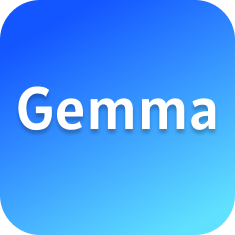Google Gemma Chat Online Free
Gemma, developed by Google, offers cutting-edge, lightweight open models. These models, with base and instruction-tuned versions, come in 2B and 7B parameters, fueled by Google’s own technology used for Gemini models. Gemma, designed with AI principles, ensures safe, reliable use with cross-device compatibility and optimization for Google Cloud and NVIDIA GPUs, globally available.
Key Takeaways
| Key Point | Description |
|---|---|
| Model Family | Gemma is a family of open language models by Google, including 2B and 7B parameter versions. |
| Accessibility | Available for free on Kaggle, Colab notebooks, and with credits for Google Cloud. |
| Compatibility | Supports multi-framework tools, various devices, and is optimized for Google Cloud and NVIDIA GPUs. |
| Responsible AI | Built with AI Principles and comes with a responsible AI toolkit. |
| Developer Access | Accessible through Kaggle, Hugging Face, Google Cloud with Vertex AI or GKE. |
| Limitations | Includes biases in data, scope of training, factual accuracy, and potential misuse. |
| Use Cases | Suitable for text generation, summarization, RAG, and both commercial and research use. |
| Gemma vs Gemini | Gemma models are lightweight and versatile, while Gemini models are larger with different use cases. |
Introduction to Gemma Models
Google’s Gemma, a lightweight, state-of-the-art open language model (LLM), is a part of the same research used in the creation of Google’s Gemini models. Gemma family equips models with two sizes, the 2B and 7B parameters versions, where each has a base (pre-trained) and instruction-tuned modifications.
How Gemma Stands Out
- Cross-Device Compatibility: Gemma models are not limited to high-end servers; they can run on laptops, desktops, IoT devices, mobile phones, and in the cloud.
- AI Principles: Google has prioritized responsible AI practices in the development of Gemma, ensuring its safe and ethical application.
Accessing Gemma Models for Development
Developers have multiple avenues to access and utilize Gemma models. These models are not only advanced but also made accessible to encourage widespread adoption and innovation.
Free Access and Credits
- Kaggle and Colab: Gemma models are freely accessible on platforms like Kaggle and Google Colab, with special credits for new Google Cloud users.
- Google Cloud: With $300 in credits for newcomers, Google Cloud becomes an attractive platform for developers to explore Gemma.
Deployment and Training
- Google Cloud Integration: Deploying and training Gemma is streamlined through Google Cloud services such as Vertex AI or GKE.
- Hugging Face Partnership: Integration with Hugging Face’s Inference Endpoints expands the reach of Gemma models.
Understanding Gemma’s Limitations
While Gemma models are powerful, they come with inherent limitations that developers must be aware of to use them responsibly.
Challenges in Language Modeling
- Biases and Data Gaps: Training data quality can impose limitations on the model’s output.
- Scope of Dataset: The breadth of the training dataset dictates the model’s expertise and limitations.
Ethical and Practical Concerns
- Misuse and Privacy: Potential misuse for malicious content and privacy violations are critical concerns that require vigilance.
Gemma’s Versatile Use Cases
Gemma models are not just technologically advanced; they are also designed to be practical and adaptable to various applications.
Broad Application Spectrum
- Text Generation: From generating text to summarization, Gemma models are equipped to handle a range of tasks.
- Research and Commercial Use: The models are available for both commercial applications and academic research.
Gemma vs Gemini: Distinguishing the Models
Gemma and Gemini models, while sharing a common foundation, are distinct in their design and intended applications.
Key Differences
- Model Size and Use Cases: Gemma models are more lightweight, making them suitable for a wider array of devices and applications.
Versatility and Compatibility
Besides being lightweight, Gemma exhibits extreme versatility by supporting a multitude of tools and systems. This includes ✅multi-framework tools, ✅ cross-device compatibility, and ✅ up-to-the-minute hardware platforms. The optimization of Gemma models extensively caters to Google Cloud, but it’s also compatible with NVIDIA GPUs.
Note: “Gemma is optimized not just for Google Cloud, but various platforms, including NVIDIA GPUs, showcasing its versatility.”
Lists of Devices Gemma Models can run on:
- Laptops
- Desktops
- IoT
- Mobile Devices
- Cloud
